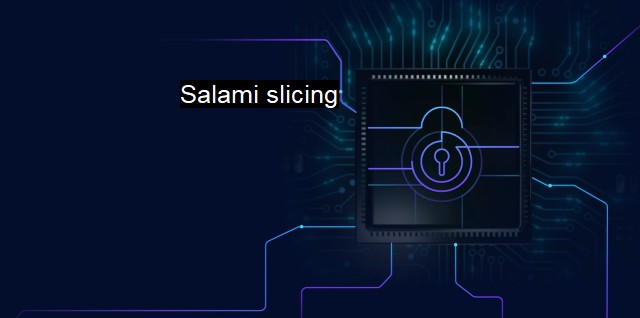What is Salami slicing?
Salami Slicing: A Stealthy Cyber Attack Technique for Data and Resource Theft
Salami slicing is a term used in information security to represent a cybersecurity threat where small, seemingly minor attacks are carried out repeatedly to accumulate into a significant breach over time. Named after salami slicing, where breaking down a whole, singular object into small links can make small, inconspicuous attacks, the term 'salami slicing' perfectly encapsulates how these types of threats evolve.The technique hinges on the principle of making actions small enough to avoid detection from regular security protocols, which are primed to seek large-scale anomalies or higher risk activities. These small-scale swipes or manipulations aren't easily noticeable individually but can yield substantial gains over time. a hacker using salami technique might siphon-off pennies from many bank accounts over time. While each transaction is minute and unlikely to affect the individual owner or be detected by the bank's transaction monitoring systems, the total accumulation could be substantial for the hacker.
The concept of salami slicing originates from the hard mathematics and computer science field known as algorithm theory. The specific techniques involved are often more sophisticated variations on social engineering, malware insertion, and data integrity attacks. Using complex coding patterns and behavioral algorithms, attackers can ensure their activities remain camouflaged.
In recent times, salami slicing has become more prominent due to increased digitalized transactions and processes. The cybersecurity sector mentions the term increasingly frequently, especially with fraud detection and prevention, antivirus creation, and information system auditing. Salami slicing is one of the techniques employed by hackers, often looking to exploit monetary systems using the averaged-out system disruption.
In response to evolving methodologies like salami slicing, cybersecurity and antivirus industries are continuously adapting. Fighting salami slicing begins with real-time, continuous monitoring using sophisticated AI-based analytics assessment. Often, detection systems seek out anomalies, like sudden, significant changes in data. In the context of a salami slicing attack, these types of security measures would be inherently ineffective, as the attacks exploit the blind spots of these efforts: they are slow, small, gradual changes barely noticeable until they amass a significant amount.
Preventing salami attacks like these require robust security models to trace smaller transactions even amidst fluctuations and noise, weeding out genuine modifications from malicious ones. smart alert systems with algorithms designed to sound off warnings when specific manipulative patterns emerge are also commonly being used in antivirus tools to mitigate salami slicing threats.
Salami slicing has notable implications in areas outside of monetary transactions as well. Targeted data extraction and corporate espionage employ salami slicing techniques, with crucial intelligence obtained bit by bit to elude detection. Login information, passwords, private files – Incremental, seemingly insignificant pieces of data are siphoned off over time, ultimately providing the culprit with enough information to perpetrate a large-scale breaching operation.
Due to the potential scale and subtlety of salami slicing, it has become a topic of consequential concern in both cybersecurity and antivirus industries. It challenges traditional methods of data protection, forcing the industry to reassess and reiterate its understanding of data theft and protection mechanisms. Addressing techniques like these is essential in maintaining the veracity of information amid the rapidly evolving landscape of data security threats.
Salami slicing, while typically small-scale and seemingly minor by nature, can result in something significant over time due to sheer persistence. This subtle, hard to detect, but potentially very destructive cybersecurity threat underscores the importance of highly developed, specific response strategies within the information security and antivirus protection sphere. As the technique continues to evolve, it will inevitably necessitate a scalable response from those vested with protecting businesses and individuals from cybersecurity threats. Having a robust defensive mechanism that can predict and mitigate such diversified forms of attack will always be a key success factor for a secure digital world.

Salami slicing FAQs
What is salami slicing in cybersecurity?
Salami slicing is a cyber attack technique in which an attacker gradually skims small amounts of money or data from many accounts or systems, adding up to a large sum or a significant compromise over time.How does salami slicing work in antivirus software?
Salami slicing works by dividing a malicious software into small components that can bypass antivirus software. The process of dividing the malware and rearranging its code is called "obfuscation."What are some preventive measures against salami slicing attacks?
To prevent salami slicing attacks, organizations can implement strong security protocols, including monitoring all financial and data-related transactions, using multi-factor authentication, installing and maintaining up-to-date antivirus protection and firewalls, and educating employees about phishing scams and suspicious activities.What are some common targets of salami slicing attacks?
Salami slicing attacks can target any online account or system that has small amounts of money or data. However, common targets include financial institutions, e-commerce platforms, payment processors, and online investment portals.| | A | | | B | | | C | | | D | | | E | | | F | | | G | | | H | | | I | | | J | | | K | | | L | | | M | |
| | N | | | O | | | P | | | Q | | | R | | | S | | | T | | | U | | | V | | | W | | | X | | | Y | | | Z | |
| | 1 | | | 2 | | | 3 | | | 4 | | | 7 | | | 8 | | |||||||